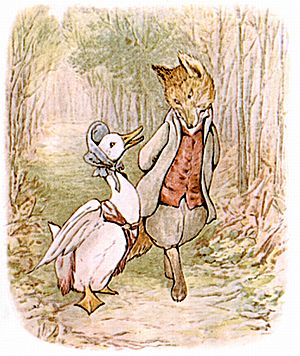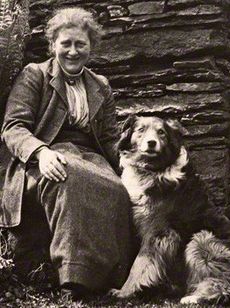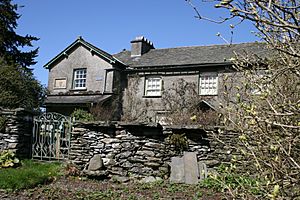The Tale of Jemima Puddle-Duck facts for kids
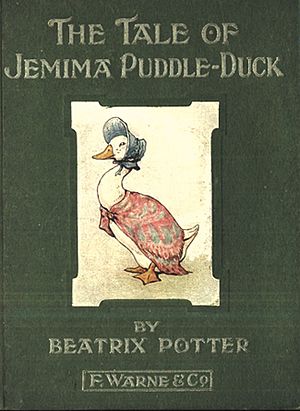
First edition cover
|
|
| Author | Beatrix Potter |
|---|---|
| Illustrator | Beatrix Potter |
| Country | England |
| Language | English |
| Genre | Children's literature |
| Publisher | Frederick Warne & Co |
|
Publication date
|
July 1908 |
| Media type | Print (hardcover) |
| Preceded by | The Tale of Tom Kitten |
| Followed by | The Tale of Samuel Whiskers or The Roly-Poly Pudding |
The Tale of Jemima Puddle-Duck is a famous children's book. It was written and illustrated by Beatrix Potter. The book was first released in July 1908 by Frederick Warne & Co.
Beatrix Potter wrote this story at Hill Top. This was a real farm in the Lake District that she bought in 1905. After buying the farm, her stories often featured country life. They included many animal characters and sometimes tricky villains. Jemima Puddle-Duck was the first book completely set at her farm. The pictures in the book show the farm buildings and nearby places.
The main character is Jemima, a duck who lives on a farm. The farmer's wife often takes Jemima's eggs. She thinks Jemima is not good at sitting on them. Jemima wants to hatch her own eggs. So, she looks for a secret place away from the farm. She meets a smooth-talking fox and tells him her problems. The fox invites her to nest in a shed at his home. Jemima doesn't know that the fox plans to cook her!
Luckily, Kep, a collie dog from the farm, finds out where Jemima is. He rescues her just in time. Beatrix Potter said this story was like a new version of "Little Red Riding Hood". Jemima, the fox, and Kep are similar to Red Riding Hood, the wolf, and the woodcutter. The characters in the book, like Jemima and Kep, were based on real animals and people at Potter's Hill Top farm.
This book became very popular. People could buy toys, painting books, and even placemats with Jemima on them. Many people think it is one of Beatrix Potter's best stories.
Contents
The Story of Jemima
The story starts on a farm where Jemima Puddle-duck lives. She really wants to hatch her own eggs. But the farmer's wife always takes them away. She thinks ducks are not good at sitting on their eggs. The farmer's wife gives the eggs to the hens instead. Jemima tries to hide her eggs, but they are always found.
So, Jemima decides to leave the farm. She puts on her special hat and shawl. She walks along the road to find a safe place to lay her eggs. She wants a place where no one will bother her.
Jemima flies to a wood she sees on top of a hill. She waddles around until she finds a good spot. It's among some tall foxglove flowers. But then, a charming gentleman appears. He has "black prick ears and sandy-coloured whiskers." He convinces Jemima to lay her eggs in a shed at his home.
Jemima follows him to his "tumble-down shed." It's strangely full of feathers. She quickly makes a nest there. Jemima lays her eggs in the shed. The fox then suggests they have a dinner party. He asks her to gather herbs for stuffing a duck. He tells her the herbs are for an omelette.
Jemima goes to the farm kitchen to get onions. There, she meets Kep, the farm collie dog. Kep asks her what she is doing and where she keeps going. Jemima tells him about her plan. Kep immediately understands the fox's trick. He finds out where the fox lives from Jemima.
Kep gets help from two fox-hound puppies. They are out for a walk near the farm. Together, they rescue Jemima. The "foxy-whiskered gentleman" (Mr. Tod) is chased away. He is seen again in another book, The Tale of Mr. Tod. Sadly, the hungry fox-hounds eat Jemima's eggs. Jemima is very sad about her lost eggs. She is taken back to the farm in tears. But later, she lays more eggs. This time, she successfully hatches four cute ducklings!
About Beatrix Potter
Helen Beatrix Potter was born on July 28, 1866, in London. Her father was a barrister named Rupert William Potter. Her mother was Helen Leech Potter. Beatrix was taught at home by governesses and tutors. She had a quiet childhood. She loved to read, paint, and draw. She also visited museums and art shows. She kept many small animals as pets in her nursery.
Beatrix loved nature and country life. She spent holidays in Scotland, the Lake District, and at her grandparents' home in Hertfordshire. As she grew up, she continued to paint and draw. In 1890, she sold six drawings of animals dressed as humans. These were used for greeting cards. She wanted to have a useful life and be independent. She even thought about studying mycology (the study of fungi). But the science world was mostly men, and they saw her as an amateur. So, she stopped studying fungi.
Beatrix stayed in touch with her last governess, Annie Carter Moore. She grew fond of Mrs. Moore's children. In the 1890s, Beatrix sent them letters with drawings and stories. Mrs. Moore saw how good these stories and drawings were. She told Beatrix to publish them. Beatrix liked the idea. In 1900, she changed a story she wrote for five-year-old Noel Moore in 1893. She made it into a small book. She couldn't find a publisher, so she printed it herself for family and friends in December 1901.
Frederick Warne & Co. had first said no to her story. But they wanted to sell more children's books. So, they changed their minds. They accepted the "bunny book," as they called it. This was after their famous children's artist, L. Leslie Brooke, recommended it. Beatrix agreed to color her drawings. The book was printed using a new color process. On October 2, 1902, The Tale of Peter Rabbit was released.
Beatrix continued to publish books with Warnes. In July 1905, she bought Hill Top. This was a working farm of about 34 acres in Sawrey, in the Lake District. She bought it with money from her books and a small inheritance. On August 25, 1905, her editor and fiancé, Norman Warne, died suddenly. Beatrix was very sad and sick for many weeks. But she managed to finish the last few stories she had planned with Norman.
Like "Little Red Riding Hood"
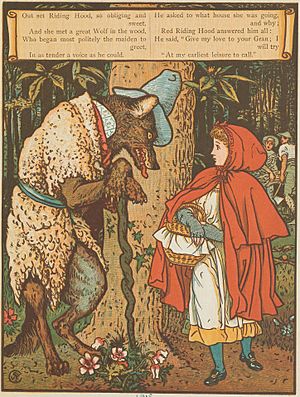
Beatrix Potter said that Jemima Puddle-Duck was a new version of "Little Red Riding Hood". There are many similarities between the two stories. Jemima and her eggs are like Red Riding Hood and her grandmother. The farmer's wife and Jemima's sister-in-law Rebeccah are like Red Riding Hood's mother. The fox and the wolf both act polite but are really wild animals. The dogs are like the woodcutters who save the day. Both stories are about being tempted and acting foolishly.
Even though Jemima's story has a happy ending, she is sad. She cries as she is led back to the farm. She lost her eggs to her hungry rescuers. She is allowed to hatch a new group of ducklings on the farm. But she only gets four. Beatrix Potter's version is more like the sad "Little Red Riding Hood" story by Perrault. It's not like the happy Grimm version where woodcutters save the heroine.
Potter knew her young readers would feel bad for the unhatched ducklings. She didn't want Jemima, a mother figure, to have a bloody end. The loss of the eggs is sad for readers. But Potter made the ending as happy as possible. This was for her audience and for the real children of her farm manager, Ralph and Betsy Cannon. The story was dedicated to them. Jemima is punished for being stubborn and foolish. She has to give up her dream of nesting away from the farm. But the punishment is not too bad. She gets to hatch one group of ducklings herself.
Jemima Toys and Books
Jemima Puddle-Duck was very popular. It was almost as popular as Peter Rabbit. So, many other products were made based on the story. Jemima is shown on one of the well-known endpapers in Potter's books. She was also on a Christmas card for a children's charity. She became the main character in a painting book that was not published. This book described the animals at Hill Top.
Jemima also appeared in Peter Rabbit's Painting Book and Tom Kitten's Painting Book. Then, in 1925, she got her own painting book. It was called Jemima Puddle-Duck's Painting Book. Beatrix Potter made this book because people really wanted another one.
Potter waited for ducklings to hatch at the farm to use as models for the painting book. But the eggs ended up being rotten. The instructions in Jemima's painting book were like those in Tom Kitten's painting book. But instead of kittens with crayons, Jemima's book had six ducklings splashing in paint water. In the original story, Jemima's eggs are eaten by her rescuers. But in the painting book, a new picture was drawn for "They took Jemima home." In this picture, Kep and the fox hound puppies lead Jemima away from her broken but uneaten eggs. This same idea was also shown on Crabtree & Evelyn chocolate Easter eggs.
The painting book shows that Potter was happy to use her characters and stories to sell things. The book told buyers about other Potter books inside the front and back covers. Other products included linen or silk placemats. Potter painted these for friends with a shorter version of the story and 12 pictures. In 1910, Potter got a patent for a soft toy duck. It was based on her model of Jemima wearing a Paisley handkerchief shawl and bonnet. A soft Jemima doll was made by J. I. Farnell of Acton.
Jemima on Screen
- In 1971, the story was part of The Royal Ballet film, The Tales of Beatrix Potter.
- In 1992, the story was shown as an episode on the animated BBC TV show, The World of Peter Rabbit and Friends.
- Jemima Puddle-Duck appears in the 2012 CGI animated TV series of Peter Rabbit on Nickelodeon.
- Jemima Puddle-Duck is in the 2018 animated and live-action film Peter Rabbit. She is also in the sequel, Peter Rabbit 2: The Runaway. Her voice is done by Rose Byrne.


